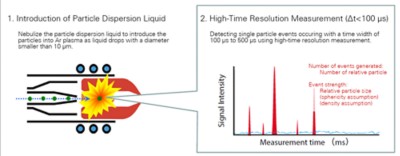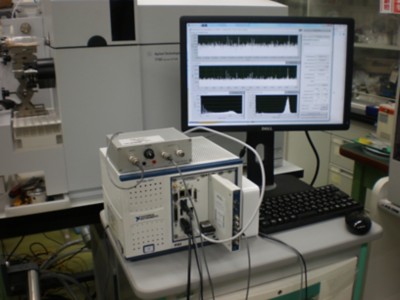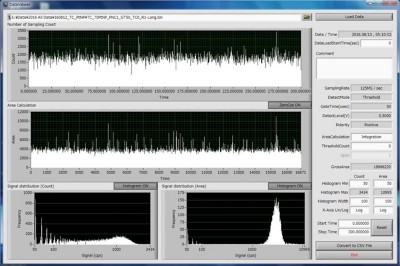A Mass Spectrometer-Based Analytical System for Nanoparticles
Kazumi Inagaki, National Institute of Advanced Industrial Science and Technology

"We used an existing mass spectrometer as the base and FlexRIO as a measurement device to successfully build, in a short period of time, a nanoparticle analysis system requiring high-speed measurement and large-volume data processing. Furthermore, the system we succeeded in building is highly flexible, so we can customize it to suit a diverse range of measurement applications."
- Kazumi Inagaki, National Institute of Advanced Industrial Science and Technology
The Challenge:
The Environmental Standards Group of AIST wanted to develop an analytical system for nanoparticles using an existing mass spectrometer as a base and adding external measurement hardware and software to achieve a system that could perform high-speed measurement and process large volumes of data.
The Solution:
We used Taiyo Corporation’s NT2600 Startup Kit, which incorporates NI PXI, FlexRIO, and LabVIEW as its foundation. This configuration helped us develop a highly customizable system that met our needs in a short period of time.
Author(s):
Kazumi Inagaki - National Institute of Advanced Industrial Science and Technology
Shin-ichi Miyashita - National Institute of Advanced Industrial Science and Technology
Hideo Akiyama - Taiyo Corporation
Introduction to Mass Spectrometry
The Environmental Standards Group is part of the National Institute of Advanced Industrial Science and Technology, Japan’s largest public research institution. The Environmental Standards Group has been striving to ensure the reliability of chemical analysis by driving more reliable analysis techniques and measurement systems that work with these techniques. Our group also provides services such as technological guidance and consulting. Our mission is to establish measurement techniques that are highly reproducible at a practical level and to introduce these to the world.
At present, we develop methods for analyzing heavy metals like cadmium, lead, and mercury in food products and environmental samples. The main instrument used in chemical analysis is an inductively coupled plasma mass spectrometry (ICP-MS) instrument. Users can determine measurements such as the amount of cadmium contained in tap water. Our group is currently focused on developing techniques for measuring nanoparticles using an ICP-MS instrument to meet an increasing demand for the formulation of regulations relating to nanoparticles, particularly in North America and Europe. In response to this trend, scientists are establishing techniques to measure the number and size of nanoparticles and evaluate their properties, while also striving to standardize terminology and knowledge. One of these techniques uses an ICP-MS instrument to measure the number and size of nanoparticles.
Nanoparticles have a size of 1 nm to 100 nm in diameter. They are already widely used in applications like cosmetics, electronic equipment, and paints, but there is some concern about the effects of nanoparticles in foods and the environment. To gain a proper grasp of these concerns, we needed a method to accurately measure the type and quantity of nanoparticles. Ordinarily, a scientist would use an electron microscope or light scattering method to measure the size and number of nanoparticles. However, these methods are not based on chemical properties, which makes it impossible to distinguish between the contents of samples if they are composed of several different mixed types of particles. Mass spectrometry is useful when dealing with these issues because we already use this technique to identify and quantify substances. For these reasons, nanoparticle analysis techniques using an ICP-MS instrument have been garnering increased attention. Many researchers are currently attempting to achieve systems that are compatible with these techniques.
We can perform nanoparticle analysis using an ICP-MS instrument using the following mechanism. This method targets the liquid used to disperse the nanoparticles (dispersion liquid). Scientists introduce nanoparticles into inductively coupled plasma by nebulizing the dispersion liquid. This causes the nanoparticles to decompose, atomize, and ionize within the plasma (Figure 1). In regular mass spectrometry, this type of process is followed by separation of the various ions according to their mass (mass-to-charge ratio), and the number (intensity) of the respective ions is measured over an elapsed time of approximately 1 s. In contrast, the objective of performing nanoparticle analysis is to measure the number of nanoparticles (the number concentration in the dispersion liquid) and the size of each nanoparticle (the particle diameter distribution within the dispersion liquid). Ion signals (events) with a time width of 100 μs to 500 μs generate every time each nanoparticle is ionized, as shown in red on the right side of Figure 1. We can determine the number of nanoparticles contained within the dispersion liquid by counting the number of events generated. Furthermore, we can ascertain the size of each nanoparticle by calculating the area of each event. This method is known as single particle ICP-MS (spICP-MS).
Why Building an spICP-MS Instrument Is a Challenge
As described above, the analytical technique known as spICP-MS was complete as a theory. However, we needed to resolve several issues to build a system that would make this theory a reality. The ICP-MS instrument used by our group satisfied the specifications that would be required of hardware to achieve this technique. In other words, it could output the required signal. However, the ICP-MS instrument was not equipped with functionality for analyzing nanoparticles because no such need existed originally. The measurement speed posed a problem. Ions from each nanoparticle were generated sequentially at intervals of 100 μs to 500 μs. This is a short time in chemical measurement using a mass spectrometer. Measurement at a time resolution of less than 100 μs (sampling rate of 10 kHz) represented a difference of more than three orders of magnitude from the usual perception of chemical measurement using a mass spectrometer.
In addition, measurement at high speeds meant that the volume of data generated would also be enormous compared to regular chemical analysis. Previously, we manually exported data to Microsoft Excel for processing. However, as the volume of data grew to huge proportions, it would take a full day to simply acquire the data from a single sample (dispersion liquid) and then perform the required calculation processes. Naturally, we needed to measure several different types of nanoparticles and repeat the measurements to confirm that they were reproducible. Therefore, the data processing task had become burdensome. We needed to build a system that would enable us to continue using the ICP-MS instrument while also performing high-speed measurements, processing large volumes of data in real time, and then storing the results. There were manufacturers who intended to sell these instruments as commercially available products. The problem was that for organizations that already owned an ICP-MS instrument, it was not usually possible to add nanoparticle analysis functionality to the instrument. Accordingly, organizations would need to purchase an extremely expensive spICP-MS system in addition to the existing ICP-MS instrument to analyze nanoparticles. Even if a manufacturer could help with a request to refurbish an existing ICP-MS instrument for compatibility with nanoparticle analysis, it would take many months to complete. If a manufacturer does bring an spICP-MS instrument to market, you would expect them to build a system that incorporated a variety of functions. However, sufficient required functions have not always been included from the outset. In fact, a better, more user-friendly system could probably be built by optimizing the system while performing the actual measurements a number of times. For these reasons, we wanted to build a system with external functionality for nanoparticle analysis added to the ICP-MS instrument, which would then offer built-in flexibility and allow customization based on the needs of each individual user.
Achieving Nanoparticle Analysis With Taiyo and NI
To build a new system based on these principles, our group started to develop a system with the cooperation of Taiyo Corporation, an NI Alliance Partner. Figure 2 shows the new system corresponding to an spICP-MS instrument. The left side shows the existing ICP-MS instrument that was used for the analyzer, while the right side shows the Taiyo Corporation product that was adopted—the NT2600 Startup Kit (NT2600). The NT2600 is a general purpose system used for recording signals, high-speed arithmetic processing, and timing processing. For the hardware, we used a PXI Chassis and PXI Controller and FlexRIO, which powers high-speed digital signal processing, and an adapter module for digitizing. We developed the required program using the LabVIEW graphical system development platform. In the system in Figure 2, the voltage signal output from the ICP-MS instrument is digitized using the adapter module (the sampling frequency can be set within the range of 20 kHz to 1 MHz), and the digitized signal is passed to FlexRIO. The FlexRIO PXI module incorporates a built-in FPGA, which aims to accelerate the complex digital signal processing that can often become an issue for engineers and scientists. There are many cases in which the signal processing related to measurement and controls, which was previously performed on the PC while running programs developed using Microsoft Excel and languages such as C and Python, can now be performed hundreds of times faster by migrating it to the FPGA. However, the degree of acceleration can differ depending on the signal processing algorithm implemented and other conditions such as the type of FPGA chip used. Therefore, the old approach of transferring data obtained using the instrument to a USB drive and then taking that data back to the desktop for batch processing will potentially be transformed to a new approach. Because the user can perform high-speed signal processing using the FPGA while the device is running, the experiment can proceed while obtaining the processing results in real time. Naturally, this improves the productivity of many engineers and researchers and contributes to their making new discoveries more quickly.
Generally speaking, specialized languages such as VHDL need to be mastered to develop programs for execution on an FPGA. Depending on the research and development period, it can be difficult to arrange for an expert to develop an FPGA when resources are limited. Meanwhile, engineers and researchers may face limitations in endeavoring to acquire the complex VHDL language when program development is not part of their core work. However, LabVIEW is widely used in the world of measurement and control, so using it with FlexRIO offers an advantage in facilitating the development of an FPGA program. If you have experience developing programs that run on a PC using LabVIEW, you can reuse that experience to develop FPGAs. Even if you do not have development experience with LabVIEW, you can still develop programs more intuitively than with text languages such as VHDL.
Figure 2 shows a system that achieves functionality and utilizes FGPA capabilities to perform high-speed measurements, then counts the number of events and calculates the event area in real time before accumulating the results.
The NT2600 includes the NT2600_FPGA data recording and arithmetic processing application and the NT2600_Windows display and saving application. The NT2600 was always equipped with functions for data acquisition, phase time measurement, and timing processing. In addition, functionality had been added to count the number of pulses in applications for electron microscopes. This meant that the hardware could be used as-is, so we only needed to program the functions necessary for nanoparticle analysis, including calculating the area. It took only three months from the beginning of discussions on this proposal to completion of this system by implementing the required functions, building the user interface, and optimizing functionality.
By constructing the system in this way, we could achieve nanoparticle analysis using the existing ICP-MS instrument (see Figure 3). This system made it possible to perform all actions such as measurements and calculations in real time, which helped us drastically reduce the operation time. Furthermore, by successfully building a highly flexible system, we could use software to optimize functionality as needed while using the system.
Future Developments
We believe that we have succeeded in developing a system that is compatible with spICP-MS and that satisfies the needs of many users. Researchers in Japan and abroad often ask us how to build this kind of system or where they can purchase such a system. As another development, Taiyo Corporation may also offer this system to customers in the chemical analysis field in the future. Furthermore, we anticipate that we can discover other new applications if we leverage the characteristics that power the performance of high-speed measurements and process large volumes of data in real time with accumulated results. Monitoring is another potential application of this system. There is already demand for verifying whether certain nanoparticles are being generated in some processes. When monitoring such processes, it may be necessary to continuously obtain the results for one to two hours, or for a half day or full day. This system could help meet these needs. Even the latest ICP-MS instrument can probably only perform 10–60 minutes of continuous monitoring. Many other fields also have a demand for processing large volumes of data in real time and accumulating the results. We hope that FPGA development will continue in those fields.
Author Information:
Kazumi Inagaki
National Institute of Advanced Industrial Science and Technology
Ibaraki 305-8563
Japan
Products in this Case Study



